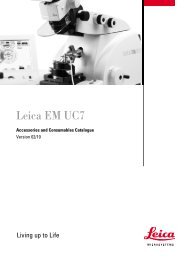Physical Principles of Electron Microscopy: An Introduction to TEM ...
Physical Principles of Electron Microscopy: An Introduction to TEM ...
Physical Principles of Electron Microscopy: An Introduction to TEM ...
Create successful ePaper yourself
Turn your PDF publications into a flip-book with our unique Google optimized e-Paper software.
108 Chapter 4<br />
remain undiffracted (undeviated) and will pass through the objective<br />
aperture. The grain structure <strong>of</strong> a polycrystalline material can therefore be<br />
seen in a <strong>TEM</strong> image as an intensity variation between different regions; see<br />
Fig. 4-12a or Fig. 4-21. A <strong>TEM</strong> image is said <strong>to</strong> display diffraction contrast<br />
in any situation in which the intensity variations arise from differences in<br />
diffracting conditions between different regions <strong>of</strong> the specimen.<br />
4.6 Dark-Field Images<br />
Instead <strong>of</strong> selecting the undiffracted beam <strong>of</strong> electrons <strong>to</strong> form the image, we<br />
could horizontally displace the objective aperture so that it admits diffracted<br />
electrons. Strongly diffracting regions <strong>of</strong> specimen would then appear bright<br />
relative <strong>to</strong> their surroundings, resulting in a dark-field image because any<br />
part<br />
<strong>of</strong> the field <strong>of</strong> view that contains no specimen would be dark.<br />
Figure 4-12b is an example <strong>of</strong> dark-field image and illustrates the fact that<br />
the contrast is inverted relative <strong>to</strong> a bright-field image <strong>of</strong> the same region <strong>of</strong><br />
specimen. In fact, if it were possible <strong>to</strong> collect all <strong>of</strong> the scattered electrons<br />
<strong>to</strong> form the dark-field image, the two images would be complementary: the<br />
sum<br />
<strong>of</strong> their intensities would be constant (equivalent <strong>to</strong> zero contrast).<br />
Unless stated otherwise, <strong>TEM</strong> micrographs are usually bright-field images<br />
created with an objective aperture centered about the optic axis. However,<br />
one advantage <strong>of</strong> a dark-field image is that, if the displacement <strong>of</strong> the<br />
objective aperture has been calibrated, the a<strong>to</strong>mic-plane spacing (d) <strong>of</strong> a<br />
bright image feature is known. This information can sometimes be used <strong>to</strong><br />
identify crystalline precipitates in an alloy, for example.<br />
With the procedure just described, the image has inferior resolution<br />
compared <strong>to</strong> a bright-field image because electrons forming the image pass<br />
though the imaging lenses at larger angles relative <strong>to</strong> the optic axis, giving<br />
rise <strong>to</strong> increased spherical and chromatic aberration. However, such loss <strong>of</strong><br />
resolution can be avoided by keeping the objective aperture on-axis and reorienting<br />
the electron beam arriving at the specimen, using the illuminationtilt<br />
deflection coils that are built in<strong>to</strong> the illumination system <strong>of</strong> a materialsscience<br />
<strong>TEM</strong>.<br />
4.7 <strong>Electron</strong>-Diffraction Patterns<br />
Diffraction is the elastic scattering <strong>of</strong> electrons (deflection by the Coulomb<br />
field <strong>of</strong> a<strong>to</strong>mic nuclei) in a crystalline material. The regularity <strong>of</strong> the spacing<br />
<strong>of</strong> the a<strong>to</strong>mic nuclei results in a redistribution <strong>of</strong> the angular dependence <strong>of</strong><br />
scattering probability, in comparison with that obtained from a single a<strong>to</strong>m



